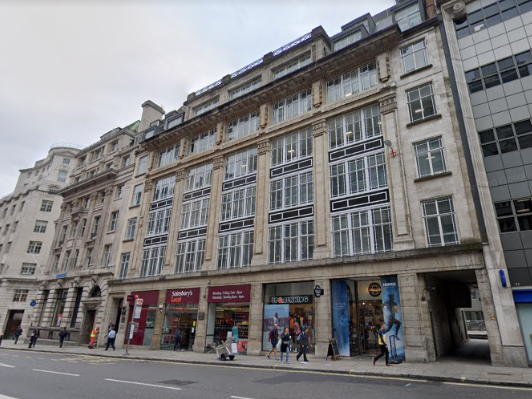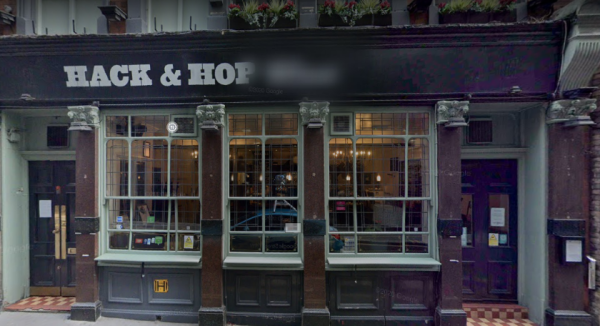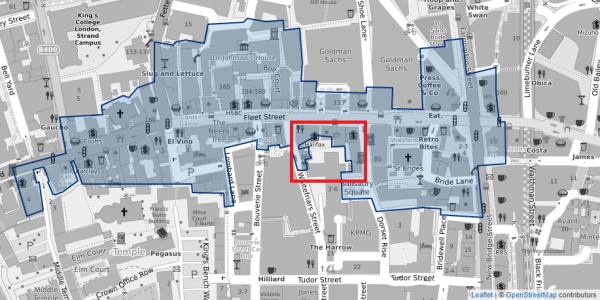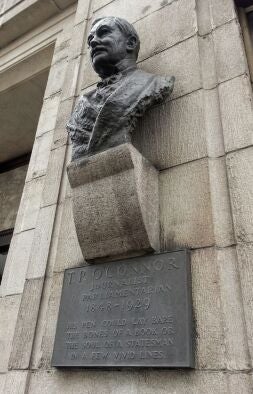
A historic Fleet Street newspaper building is set to be demolished in a blow to the journalistic heritage of the area.
Chronicle House (pictured), at 72-78 Fleet Street, was designed and built in 1924 for the newspaper trade by Hebert, Ellis & Clarke in a stripped back classical style according to conservation campaign group Save Britain’s Heritage.
Agence France-Presse was housed in Chronicle House until 2009, leaving DC Thomson journalists as the last on Fleet Street until they too left five years ago.
The former newspaper office will be demolished along with two historic buildings on either side including 80-81, which housed the Daily Chronicle until 1930 and was most recently a Barclays Bank.
They will make way for a new “justice quarter” including City of London Police headquarters, a court building and offices.
Other buildings affected include the Hack and Hop pub, formerly the Coach and Horses, on Whitefriars Street. The building dates from the 19th century with a Victorian facade and the latest iteration of the pub commemorates the area’s heritage with newspaper headlines around the bar.

Hack & Hop pub on Whitefriars Street. Picture: Google Street View
And 8 Salisbury Court is also to be demolished. Salisbury Court is the birthplace of Press Gazette, which was founded in 1965 by Colin Valder, and it features plaques commemorating the publication of the first-ever print edition of The Sunday Times there and the birthplace of diarist Samuel Pepys.
The buildings are all located within the Fleet Street Conservation Area, but none are protected by listed status.
The Twentieth Century Society, which objected to the proposals, cited the Chronicle House building’s “construction during the later boom years of the newspaper industry.
“We consider the buildings to have considerable group value in connection with other inter-war newspaper buildings within the Fleet Street Conservation Area”.
The plans were approved by the City of London’s Planning and Transportation Sub-Committee on Thursday but Marcus Binney, executive chairman of Save Britain’s Heritage, told Press Gazette the group will continue to push for a public inquiry.
It has already written to Housing, Communities and Local Government Secretary Robert Jenrick to request one, with plans to next launch a petition.
Binney said the new buildings – which will rise to seven, eight and ten storeys – would be a “wholly unworthy” replacement and inclusion in an area of such grand heritage and criticised the way the City had been “the judge of its own case” as it is applicant, landowner and decision maker.
[Read more: Why Fleet Street is still British journalism’s spiritual home]
Ahead of Thursday’s meeting, a planning officer’s report said the development would cause “less than substantial harm” even though the six buildings to be demolished “make modest to high contributions to the character and appearance and heritage significance of the Fleet Street Conservation Area, as a whole”.
The report said the proposed replacement buildings would nonetheless preserve the character, appearance and heritage significance of the area.
Historic England also raised concerns about the impact on the area around nearby St Bride’s, often known as the Journalist’s Church, just off Fleet Street. The view of the spire, also at risk, was reputed to be the template for what has become the traditional wedding cake.
The planning officer said there would be a minor impact on the “special interest and heritage significance” of St Bride’s “as the result of a slight diminishment in its local and wider riparian townscape presence, in particular in important views of civic/historical resonance”. But their report added the church would also be enhanced slightly by being part of a vista to the rear of the new courts building.

Rough area of Fleet Street affected by Justice Quarter plans.
The map above shows the area affected as it lies within the conservation area – Chronicle House is the centre of the three Fleet Street fronting buildings affected, with the Hack and Hop on the left downward spear and St Bride’s just one road over to the right.
The former Reuters and Press Association building at number 85, built in the 1930s, is also directly adjacent.
Chronicle House carries a memorial plaque to TP O’Connor, the Irish journalist who lived from 1848 to 1929, founded four publications and was the only ever Irish Nationalist MP to have a seat in England.
It carries the inscription: “His pen could lay bare the bones of a book or the soul of a statesman in a few vivid lines.”

Henrietta Billings, director of Save Britain’s Heritage, said: “Conservation areas like this one are designed to recognise and protect the special character, flair and heritage of our important streets and places.
“Fleet Street is famous for its rich newspaper history, as well as its largely well-preserved streets and alleyways and medieval street pattern. Large scale demolition-creep of this kind is crass and short-sighted in any location – let alone in a so-called conservation area.”
Alistair Subba Row, chairman of the Fleet Street Quarter Partnership to support the local business community, supported the proposals.
He said: “Some 30 years ago the newspaper industry left Fleet Street leaving behind iconic City buildings which became the home to Freshfields, Deloitte and Goldman Sachs. Today those buildings are empty once again having reached the end of their internal life.”
He added that the new development would be a “crucial piece of the next chapter in Fleet Street’s history”.
Fleet Street was the centre of national newspaper journalism and printing in the UK from the 18th century until the mid-1980s.
The last journalists left Fleet Street five years ago with the departure of three Sunday Post editorial staff. DC Thomson has kept its landmark office on the road but it is staffed by non-editorial departments like advertising.
Reuters was among the last newsrooms based on Fleet Street before it moved staff to new offices in Canary Wharf in 2005. Agence France Press departed a few years later in 2009.
The ex-Daily Express listed art deco office, latterly housed by Goldman Sachs, is one of the most beloved pieces of architecture on the street. Binney said he thought the public ought to be able to access its grand foyer.
Picture: Google Street View
Email pged@pressgazette.co.uk to point out mistakes, provide story tips or send in a letter for publication on our "Letters Page" blog
